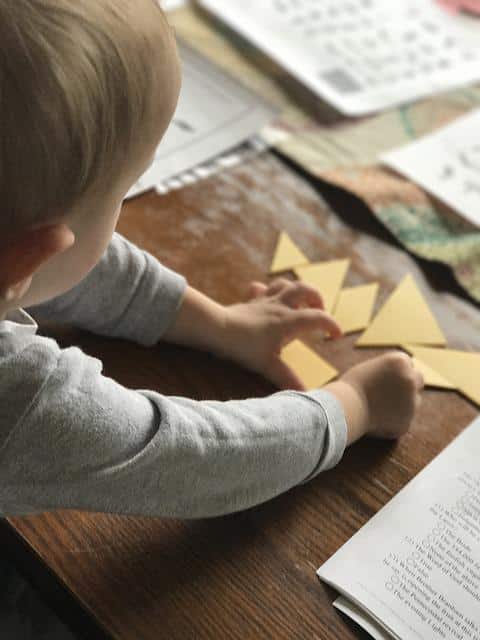Last Updated on February 9, 2024 by JigsawPuzzleGuru
The tangram puzzle is likely one of those things that you’ve actually seen and tried but perhaps were unaware of the name. This famous 7-piece flat puzzle hails from China, supposedly created in the 18th century. After this time, the tangram puzzle was exported to Europe and the US on trade ships, where it found enormous popularity.
In today’s blog, we’re taking a deep dive into the fascinating history and sometimes infuriating puzzle-solving world of the tangram, looking at its origins, how it works, what makes it unique, and some other interesting aspects this puzzle presents to our beleaguered brains.
Table of Contents
What is a Tangram? Where Does it Come From?
Let’s start with a description and an origin story. The tangram puzzle is a set of seven flat polygon shapes: 2 large triangles, one medium triangle, two small triangles, 1 square, and one parallelogram. The geometrically minded puzzlers will immediately notice an interesting fact: all these shapes can be divided into the small triangle polygon.
The product arrives with the pieces arranged across a flat, square board. The first challenge that people with the tangram face is to remove the pieces from the board, shuffle them up, and then replace them in their square. That seems simple enough, right? But, as you’ll quickly discover, it’s devilishly tricky at first, and putting them back into the square is just the first of many thousands of puzzles that the tangram gives you.
The beauty of this puzzle is that it’s 10,000+ puzzles all in one. The primary function of the tangram that has made it so popular over the years is that the seven pieces can seemingly be arranged into countless different shapes. A good tangram set will be accompanied by a booklet with silhouette outlines that you then have to recreate using only the seven pieces of the set. You have to use all seven pieces, and none of them can overlap. However, some of the puzzles may include gaps or spaces created by the way other shapes fit together.
Below is a summary of the rules for completing any tangram puzzle:
● All seven pieces must be used in every final shape
● The pieces must be flat, connected, and not overlapping
● Spatial gaps that naturally form are permitted, as long as the pieces are otherwise interlocked
● It is permitted to rotate and flip the pieces to form shapes
Origins
The tangram is thought to have originated in China and is known in Chinese as the 七巧板 (qī qiǎo bǎn), which translates to “seven boards of skill.” The “seven” clearly refers to the seven pieces of the puzzle, and the “skill” is the art of putting them together first back into their square of courses, but then, more importantly, into the many possible shapes.
The exact origin of the name “tangram” is unclear, however, with the suffix “gram” coming from the green for “written character” or “that which is drawn,” but the origins of “tan” are unclear. The word ‘tan’ could be a regional Chinese dialect of ‘bǎn’ 板, which means “board.” Other theories point to the more archaic English word “tangram,” which simply means “an odd or intricately contrived thing.” It seems all explanations are logical.
Puzzle Shapes
There has never been any serious attempt to calculate the number of possible shape combinations that are possible with the tangram pieces. A somewhat arbitrary number of 10,000 has been cast out before, but it has no real meaning in any numerical calculation. People seem to come up with new combinations all the time, which is a big part of the fun of the tangram.
While many tangram puzzlers start with the booklet of silhouettes to get their inspiration, they may quickly evolve into trying to form exciting shapes independently without guidance. Of course, many of these shapes will have been made and documented before, but with seemingly no ceiling on what puzzlers can do with the tangram pieces, it seems the story will continue as long as people have the patience to keep putting them shapes together.
The beauty of tangram and the story of its popularity are rooted in its elegant simplicity. It’s easiest to buy yourself a pre-cut board and play with the pieces that way, but many without even the resources for a tangram puzzle can cut out the shapes using paper or cardboard and make their own version. As a result, the shapes are the same in every puzzle.
Tangram Paradoxes
An exciting phenomenon discovered with the tangram puzzle is the so-called tangram paradox. There are three paradoxes in particular that stand out: the Two Monks, the Magic Dice Cup, and the Clipped Square. What makes them paradoxical?
First of all, these are shapes that are made with the same number of shapes but somehow produce almost identical shapes but with a notable and significant difference, usually formed from the shifting of a single piece. In the Two Monks, for instance, one version shows a monk with an arm outstretched, but no foot. The second creates the same shape but now has a foot? How could the same seven pieces do that? So one of the small triangles is moved from the “belly” to create the foot underneath. The two large triangles are then rearranged to form the whole body, with the medium triangle reversed to the other side. Presto – the same shapes make the same final form.
The most bizarre paradox is also apparently the simplest, however, which is the Clipped Square. This shows first the tangram pieces in their original square form, then the pieces arranged to create the same square but with the top-right corner missing. As a result, the tangram puzzle is fascinating and infuriating for puzzlers everywhere.
Tangrams and Math
Tangrams are an excellent method through which to boost one’s mathematical skills and problem-solving abilities. The tangram leads to a greater understanding of the different relationships between geometric shapes. Even the fundamental understanding that the tangram can be understood either as the interconnection of 7 pieces with different shapes, or as another number of small triangle pieces, some of which are preset into different forms, gets the mind racing and the imagination roaring.
Besides geometric shapes, another key mathematical concept that the tangram teaches is area. As puzzlers learn to understand the blocks to be formations of smaller triangles that also exist in the set, they can start to understand better how area is calculated and formed using different shapes. Breaking down a complex area into simpler shapes you can quickly calculate the area for is a crucial math skill that kids can apply later in their education journey.
It is for this reason that the tangram is so beneficial to kids as a tool to boost their cognitive development, as well as their critical thinking, patience, and perseverance. As puzzlers increasingly learn how the different pieces can go together, they start to see how complexity can be created from simple elements. Such thinking is the foundation of critical professional skill-sets needed in fields like engineering.
Tangram: The Puzzle of 10,000 Uses
Unlike puzzle games and block-building activities like Lego, which have become exceedingly expensive to buy, the humble tangram remains the budget-friendly alternative that will provide endless scope for problem-solving and education. Tangrams are small enough to fit in a desk drawer or a satchel and can be carried around and practiced anywhere you have a table and some free time. There’s no better way to keep your mind occupied and exercised.









